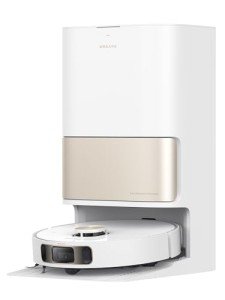Robotic Vacuum Cleaner Comparison: The Future of Home Cleaning
In recent years, robotic vacuum cleaners have transformed the way we maintain tidiness in our homes. With advancements in technology and the incorporation of artificial intelligence, these devices have actually progressed from mere novelty items to important household home appliances. This article supplies a thorough comparison of a few of the leading robotic vacuum on the marketplace, assisting consumers make informed decisions when choosing a model that suits their requirements.
Understanding Robotic Vacuum Cleaners
Robotic vacuum are self-governing makers designed to tidy floorings immediately. Geared up with robotic vacuum cleaner on sale , they navigate around obstacles and change their cleaning paths for maximum effectiveness. The key functions that separate different models include suction power, battery life, app connection, navigation innovation, and price.
Key Features to Consider
When comparing robotic vacuum, possible purchasers need to take into consideration the following aspects:
- Suction Power: Measured in Pascals (Pa), suction power determines the efficiency of picking up dirt and particles.
- Battery Life: The length of time a vacuum can run before needing a recharge significantly impacts its cleaning performance.
- Navigation Technology: Models might use simple random navigation or innovative mapping technologies (like LIDAR) that enable them to produce a map of the home.
- Smart Features: Connectivity to smart device apps or smart home systems can enhance functionality and control.
- Filter Type: HEPA filters are advised for allergy sufferers, as they trap irritants and enhance air quality.
Comparison of Top Robotic Vacuum Cleaners
Below is a comparison table of a few of the very best robotic vacuum cleaners available in 2023:
| Model | Suction Power (Pa) | Battery Life (min) | Navigation Technology | Smart Features | Price (GBP) |
|---|---|---|---|---|---|
| iRobot Roomba i7+ | 1700 | 75 | Smart mapping | App control, voice command | ₤ 949 |
| Roborock S7 | 2500 | 180 | LIDAR | App control, multi-floor | ₤ 649 |
| Neato D7 | 2000 | 120 | LIDAR | App control, zone cleaning | ₤ 599 |
| Ecovacs Deebot T10 | 3000 | 150 | Smart mapping | App control, space detection | ₤ 799 |
| Shark IQ Robot | 1200 | 90 | Random | App control, self-emptying | ₤ 399 |
Explanation of the Table
- iRobot Roomba i7+: Known for its robust cleaning ability, it features smart mapping technology that permits it to designate particular locations for cleaning. Its self-emptying function is a plus for convenience.
- Roborock S7: This model stands out in suction power and battery life, making it ideal for bigger homes. Its LIDAR innovation helps develop an efficient cleaning course, and it can vacuum and mop at the same time.
- Neato D7: The D-shape design permits better corner cleaning, and it includes strong suction power. Its LIDAR navigation allows it to map out cleaning areas precisely.
- Ecovacs Deebot T10: Boasting the highest suction power and advanced navigation, this model can deal with several floorings effectively. It's a versatile option for households with differing floor types.
- Shark IQ Robot: An economical option that still uses smart features. Its self-emptying ability and app integration make it a practical choice for those trying to find a solid cleaning buddy without breaking the bank.
Advantages of Robotic Vacuum Cleaners
Robotic vacuum cleaners use many benefits that add to their rising popularity among customers:
- Time-Saving: Automated cleaning permits users to maximize important time that can be spent on other activities.
- Convenience: Many models can be set up via apps to clean at particular times, minimizing manual effort.
- Ease of access: They can reach under furnishings and in tight areas where traditional vacuums might struggle.
- Daily Maintenance: Regular use of robotic vacuums can assist keep a regularly tidy environment, promoting better overall home hygiene.
FAQs About Robotic Vacuum Cleaners
1. How frequently should I run my robotic vacuum?
It is suggested to run the robotic vacuum a minimum of 2-3 times a week to keep tidiness, though daily usage can be beneficial, especially in homes with pets or high foot traffic.
2. Do robotic vacuums work on carpets?
Yes, lots of robotic vacuums are designed to deal with carpets, however effectiveness may vary based upon the design's suction power and brush type. Search for designs specifically pointed out as reliable for carpets.
3. Can robotic vacuums clean family pet hair?
A lot of robotic vacuums can successfully get pet hair, but those with strong suction and tangle-free brush designs are particularly appropriate for this task.
4. How do I keep my robotic vacuum?
Routine upkeep consists of cleaning the brushes and sensors, clearing the dustbin, and sometimes replacing filters to make sure optimum efficiency.
5. Are robotic vacuums worth the investment?
While they tend to be more costly than traditional vacuums, the benefit, effectiveness, and time-saving aspects make them a worthwhile financial investment for lots of homes.
The market for robotic vacuum continues to broaden as technology progresses, providing customers a variety of choices to match various cleaning needs and spending plans. By thoroughly thinking about features such as suction power, battery life, and smart capabilities, users can select a design that aligns with their lifestyle. Whether for benefit, ease of usage, or superior cleaning performance, robotic vacuums are unquestionably improving the future of home cleaning.

